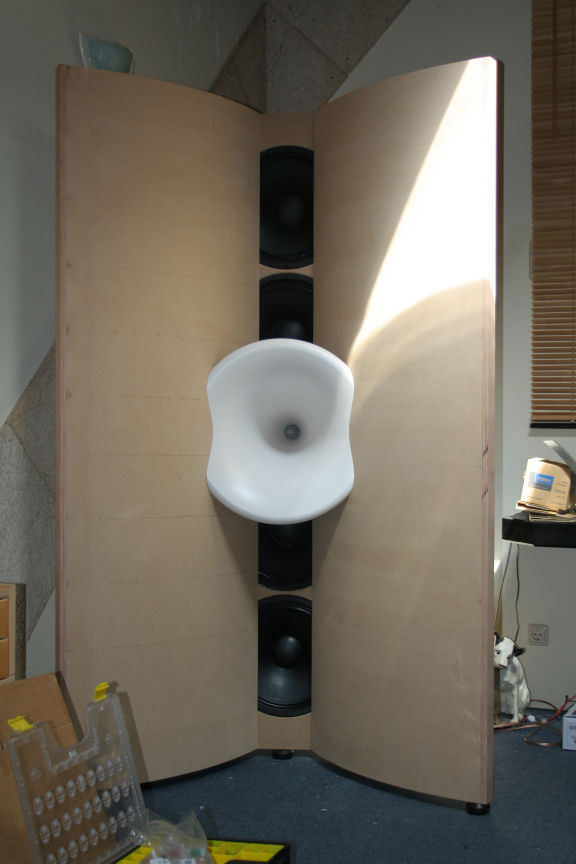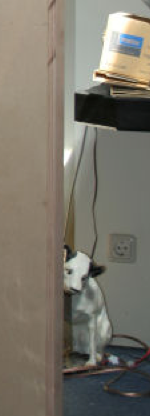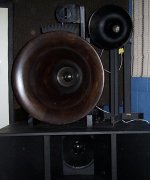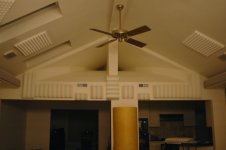Just had a quick look around and discovered this: M.F.D.S.. - solve the problem by excising the spider! Haven't checked for any comments about this in diyAudio; would be very interesting to have a listen to its characteristics ...
Edit: and also this mob, http://terraspeakers.com/about-us/our-technology/
Edit: and also this mob, http://terraspeakers.com/about-us/our-technology/
Last edited:
AR did that back in the last century for some of their midrange drivers, Lowther have used the same material for their spiders as they use for their surrounds (foam) for some of their early models, on one of the early B&W woofers the spider was just to keep the dirt out, the "real spider" was hidden under the dust cap, it was a 3 legged spiral cut piece of fiberglass PC board.
Just had a quick look around and discovered this: M.F.D.S.. - solve the problem by excising the spider! Haven't checked for any comments about this in diyAudio; would be very interesting to have a listen to its characteristics ...
Edit: and also this mob, Our Technology - Terra Speakers | Terra Speakers
You could opt to replace the spider with a wire suspension like Steen Duelund used to do: http://www.steenduelund.dk/scanspeak8554.pdf
😉
Actually Ted Jordan had done a variety of suspension, wired in the Jordan Watts, foam in the JX125 and JX150, and a spiderless Jr6x (I think that's what it is called). Each had their pros and cons. There were some ideas about spider design floating around here, and I was hoping to consolidate some ideas to tweak the spider design at a later date. The real difficult part is trying to find a good BL and Km match over reasonable range. Also working on an amp design that will hopefully more closely integrate with driver characteristics.
Exactly why I asked the (unanswered) questions in post #9485.Rather than treat the loudspeaker as an idealized black box, we have to look at how each element actually performs, and see whether existing measurements capture the behavior or not.
Hello, I wonder if the floor reflection might have more effect than the math predicts.Another difference between horn and direct-radiator bass is the effect of the floor bounce, which creates a null that might fall at an unfortunate frequency (close to the crossover). The mouth of a bass horn is usually right next to the floor, which effectively creates a mouth with twice the area, since the floor image merges with the physical mouth above the floor.
This doesn't happen with an Onken or typical enclosures for 15" drivers. The bass driver is above the floor, which creates 2 apparent sources from the listening position ... the physical driver, and the reflected floor image. There are additional reflections from the back and side walls, but these have substantially more delay.
Part of the annoying jiggery-pokerey of moving a conventional stand-mounted 2-way so that it sounds smooth is really adjusting the timing of the 3 reflections (floor, rear wall, side wall) so the overall response is more or less smooth in the 200 Hz to 800 Hz region. Unfortunately, the smoothest-response location is probably not going to be the best-image location, so the result in most rooms is a compromise.
Here's a convenient little floor-bounce calculator. Keep in mind that there's a 3~6 dB peak at twice the null frequency, and another null at three times the null frequency.
In principle, a vertical array of woofers going from floor level to the desired listening height should sidestep the floor-bounce issue, but the commercial systems that take this approach don't sound right to me ... kind of blurred and bass-heavy, nothing like horn bass at all. The commercial systems with a single 15" bass driver close to the floor also sound murky and dark.
Possibly the trouble with a vertical bass array is too much output from the driver closest to the floor ... since the lower driver "sees" the floor reflection, it raises the effective efficiency (gain) of the driver. If a vertical array is used, perhaps it's better if the array has the response shaded so the upper drivers are more efficient ... in the example of this system, the upper driver would be a 515, while the lower driver would be a 416. The 2~3 dB difference in efficiency would just about compensate for the increased gain of the driver closest to the floor.
If 1/4 in really matters for driver alignment, then the direct sound and reflect sound mixing together might have a bad effect.
If you or anyone else explored this?
Floor bounce has been measured and heard by many:Hello, I wonder if the floor reflection might have more effect than the math predicts.
If 1/4 in really matters for driver alignment, then the direct sound and reflect sound mixing together might have a bad effect.
If you or anyone else explored this?
The Floor-Bounce Effect – Mic Placement for Equalization Synergetic Audio Concepts
The math predicts correctly, but the path length differences from floor bounce are much greater than 1/4", so show up in the low mid range rather than in the high frequencies.
A 60" tall array with a horn in the path of the middle speakers will "help" provide multiple floor and ceiling bounce issues as well as reflections from the back of the horn.An array like this might help:
The dog in the background appears to be trying to hang himself, my reaction would not be that extreme 🙂.
Attachments
Last edited:
The dog in the background
Isn't that a small Nipper statue?
I think I'd build a box before i'd waste my time on building something like that open baffle "waveguide" thingee. 😉
I think I'd build a box before i'd waste my time on building something like that open baffle "waveguide" thingee. 😉
This is where I have got to.
There are too many flaws in the components used in making a complete speaker, using only the design software and testing software. Nobody can really apportion with absolute accuracy what what each and every part can do, and there are so many different directions with drivers alone.
We all started with some idea of what we were going to do, but a very few find some insight, that directs them to making an outstanding component or even whole system.
We can all cite examples of this from the past. But at the moment we wait forthis insight and in the meantime keep trying our own ideas. Suck it and see.
Some low-level input
Lynn -
I'm definitely with you on the whole low-level signal issue and the concerns about spider materials etc.
My own activities with the 120Hz tractrix horn -
audio-talk :: View topic - Something stirs in the Undergrowth
..have led me to conclude, so far, that the Fane Studio 8M may not be ideal for this application - it's quite a heavy-duty driver, and it doesn't sound as good, at normal playing level , in this horn , than the B&C 8PE21 that I tried before. I wonder if Martin was really on the right track with these bass or bass/mid horns in using the Lowther PM2A or Vitavox drivers, which are designed for lower-level signals ? As you say - the horn-loading can't help but show-up these problems, given the very low excursions.
I wonder also if Romy's use of the Tannoy 'injection' channel was a way of fixing this problem ?
Makes one think that the compression driver, with its aluminium flexures, is a very attractive technical approach to the low-level signal issue .
Meanwhile, here is my take on how to drive the two horns , avoiding the passive crossover . Apologies to Lynn for the 1st-order slopes, but I'm with Bruce on this : from the limited work I've done with 1st vs. 2nd-order slopes with the AH425 / Onken or AH425 / 120Hz horn .
audio-talk :: View topic - A 2 or 3-channel SE 'Horn-amp'
Lynn -
I'm definitely with you on the whole low-level signal issue and the concerns about spider materials etc.
My own activities with the 120Hz tractrix horn -
audio-talk :: View topic - Something stirs in the Undergrowth
..have led me to conclude, so far, that the Fane Studio 8M may not be ideal for this application - it's quite a heavy-duty driver, and it doesn't sound as good, at normal playing level , in this horn , than the B&C 8PE21 that I tried before. I wonder if Martin was really on the right track with these bass or bass/mid horns in using the Lowther PM2A or Vitavox drivers, which are designed for lower-level signals ? As you say - the horn-loading can't help but show-up these problems, given the very low excursions.
I wonder also if Romy's use of the Tannoy 'injection' channel was a way of fixing this problem ?
Makes one think that the compression driver, with its aluminium flexures, is a very attractive technical approach to the low-level signal issue .
Meanwhile, here is my take on how to drive the two horns , avoiding the passive crossover . Apologies to Lynn for the 1st-order slopes, but I'm with Bruce on this : from the limited work I've done with 1st vs. 2nd-order slopes with the AH425 / Onken or AH425 / 120Hz horn .
audio-talk :: View topic - A 2 or 3-channel SE 'Horn-amp'
Low level detail is a byproduct of "fully horn loaded" - when you achieve 108 db/w/m over say 60 to 12K you have a system that more then likely will reproduce and follow low level transients that hide in lesser systems. For example my full range 85 db/w/m electrostats loose most of it but still manage to sound pleasant, pleasant but not real.
PS- this romy character, why do people listen to somebody (and repaeat the mistakes) that can't figure out round bass horns are a huge waste of time and materials? A rectangular horn can take up much less precious space (especially vertically!) and rectangular horns can be spaced much closer together to create much more humongous sound and coherency with better controlled dispersion.. Round horns frankly are a fad. "Spherical wave fronts" BUNG
PS- this romy character, why do people listen to somebody (and repaeat the mistakes) that can't figure out round bass horns are a huge waste of time and materials? A rectangular horn can take up much less precious space (especially vertically!) and rectangular horns can be spaced much closer together to create much more humongous sound and coherency with better controlled dispersion.. Round horns frankly are a fad. "Spherical wave fronts" BUNG
Last edited:
Lynn -
I'm definitely with you on the whole low-level signal issue and the concerns about spider materials etc.
My own activities with the 120Hz tractrix horn -
audio-talk :: View topic - Something stirs in the Undergrowth
..have led me to conclude, so far, that the Fane Studio 8M may not be ideal for this application - it's quite a heavy-duty driver, and it doesn't sound as good, at normal playing level , in this horn , than the B&C 8PE21 that I tried before. I wonder if Martin was really on the right track with these bass or bass/mid horns in using the Lowther PM2A or Vitavox drivers, which are designed for lower-level signals ? As you say - the horn-loading can't help but show-up these problems, given the very low excursions.
I wonder also if Romy's use of the Tannoy 'injection' channel was a way of fixing this problem ?
Makes one think that the compression driver, with its aluminium flexures, is a very attractive technical approach to the low-level signal issue .
Meanwhile, here is my take on how to drive the two horns , avoiding the passive crossover . Apologies to Lynn for the 1st-order slopes, but I'm with Bruce on this : from the limited work I've done with 1st vs. 2nd-order slopes with the AH425 / Onken or AH425 / 120Hz horn .
audio-talk :: View topic - A 2 or 3-channel SE 'Horn-amp'
If the input signal was measured for level, HD IMD and the output sound was measured similarly for a selection of musical sounds starting from an out put of the onset of audibility to some figure say a typical 85dB listening level then the onset of diaphragm initiation would become visible and could be related to the compliance of the spider and diaphragm surround. The Radian 745Neo was likely never designed with very low level outputs. Surely driver manufacturers do this to assist in the finalised design. Do Radian claim anything for low outputs ?
Last edited:
"Round horns frankly are a fad"
An expensive and extremely rare fad, given the price of a pair of 100Hz round horns ( ? )
An expensive and extremely rare fad, given the price of a pair of 100Hz round horns ( ? )
PS- this romy character, why do people listen to somebody (and repaeat the mistakes) that can't figure out round bass horns are a huge waste of time and materials? A rectangular horn can take up much less precious space (especially vertically!) and rectangular horns can be spaced much closer together to create much more humongous sound and coherency with better controlled dispersion.. Round horns frankly are a fad. "Spherical wave fronts" BUNG
Here is a pic of Romy's 250Hz cut off mid bass horn mouths, they are a straight horn and built into the area above the kitchen. His seating position is time aligned between these and the round horn system at the other end of this room. His true bass is still provided by 4 or 5 stacked 10" bass drivers in individual sealed cabinets per channel, no ports.
Attachments
- Home
- Loudspeakers
- Multi-Way
- Beyond the Ariel



